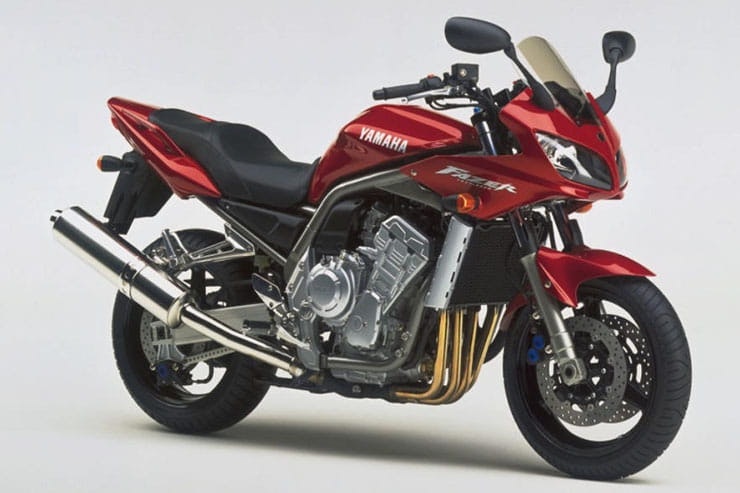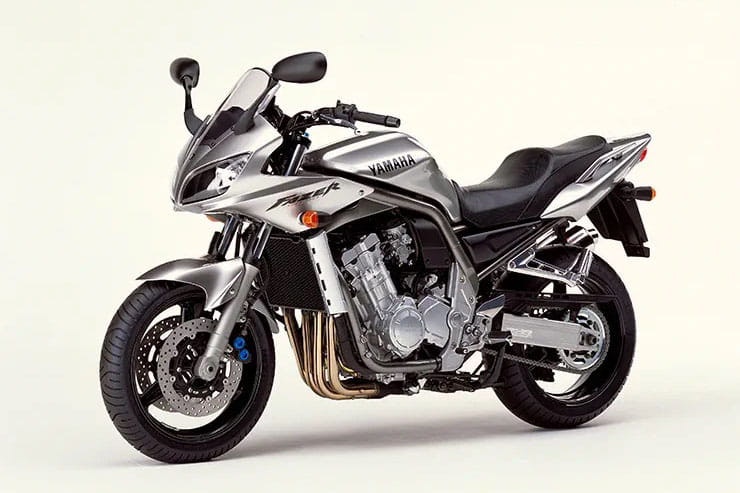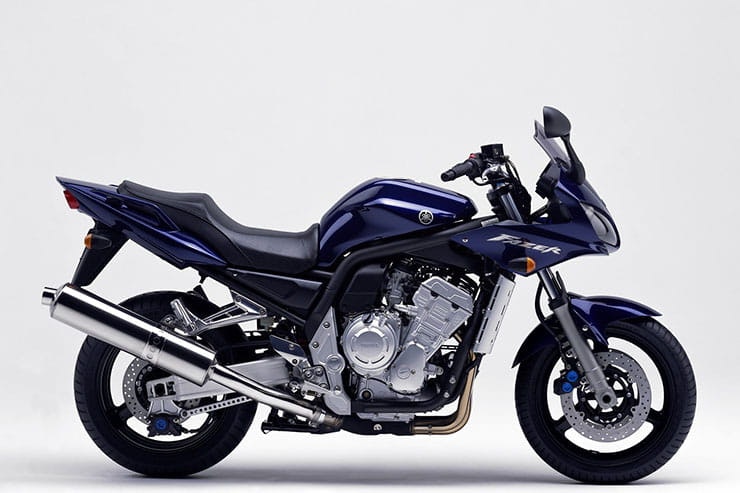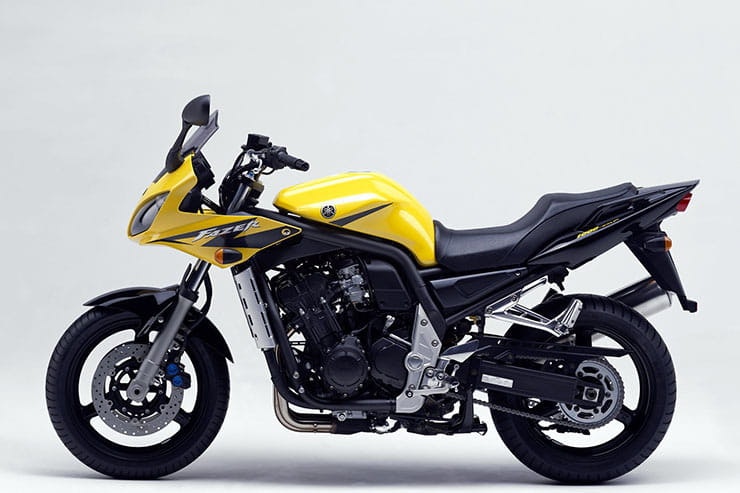Yamaha FZS1000 Fazer (2001-2005): Review & Buying Guide
By Jim Moore
Bike journo for a quarter of a century
13.02.2024
Price: £1500-£3000 | Power: 143bhp | Weight: 208kg | Overall BikeSocial Rating: 4/5
Yamaha’s intention for the FSZ1000 Fazer was simple: combine superbike performance with relaxed ergonomics. At the turn of the millennium when the big Fazer concept was taking shape, the marriage between those two elements hadn’t yet been tried. Sure, bikes like Suzuki’s GSF1200 Bandit and Kawasaki’s ZRX1100 gave a taste of what was possible, but Yamaha’s expectation for the FZS1000 was far greater, with the design team deliberately creating a machine significantly different to anything else. As a result, the Fazer 1000 was arguably the original hyper naked.
Marrying R1 power (143bhp and 78lb.ft) with streetbike sensibilities and practicality was a stroke of genius, even if it did take both the motorcycle press and buying public a while to appreciate it. The big Fazer wasn’t the sales success its smaller sibling, the FZS600, proved to be, perhaps because Yamaha did little to dampen the 998cc engine’s performance from R1 spec. The 600 was brilliant, easy fun whereas the 1000 was maybe too much on paper for many riders back in 2002, despite journos bemoaning the fact it didn’t have the punch of its superbike sibling.
Either way, we were both wrong. The Fazer 1000 is a brilliant road bike, even 20-plus years on from its launch. Not only that, this Yamaha is now astonishing value for money – £1500 upwards buys something tidy and ready to ride; £3000 secures a minter. So why pay R1 money when you can have similar performance and way more comfort for half the price?
Yamaha FZS1000 Fazer (2001-2005): Price
The Fazer was part of Yamaha’s range for five years. In that time changes were limited to just colours and graphics, before the FZS was replaced by the FZ1 in 2006.
2001 FSZ1000 values: Rough £1200-£1400; Tidy £1500-£1800; Mint £2000-£2300
998cc inline four, DOHC 20v half-faired street bike. Steel double cradle frame, monoshock, aluminium swingarm. 143bhp, 208kg. Colours: red, blue, black
2002 FSZ1000 values: Rough £1300-£1500; Tidy £1700-£2000; Mint £2200-£2500
Silver colour added. Colours: red, blue, black, silver
2003 FSZ1000 values: Rough £1500-£1650; Tidy £1900-£2200; Mint £2400-£2650
Stylistic update. Two-tone body colours, engine colour changed from silver to black. Colours: red/black, yellow/black
2004 FSZ1000 values: Rough £1700-£1900; Tidy £2400-£2600; Mint £2700-£2800
Body colours now two different shades of silver – Silver Storm and Silver Tech. Colours: silver
2005 FSZ1000 values: Rough £2000-£2300; Tidy £2650-£2850; Mint £2900-£3000
Return to single solid colours, engine still black. Colours: blue, grey red
A hell of a lot of bike for the money
Hilarious electronics-free R1 motor
All day comfort and decent level of practicality
Forgettable styling
Build quality – corrosion takes hold too easily
Previous owners – avoid anything dripping with cheap, aftermarket tat
Yamaha FZS1000 Fazer (2001-2005): Engine and Performance
Creating an engine from scratch was unnecessary. Yamaha already had what it needed – the short, compact, light and immensely powerful unit from the YZF-R1. But rather than simply shoehorn the 20-valve unit straight into a street chassis, complete with its space-saving stacked gearbox, Yamaha made tweaks to better suit the engine to its new role.
Increased midrange stomp was the aim, so the R1’s 40mm downdraught Mikunis were dropped in favour of horizontally mounted 37mm carbs. This change necessitated a completely new cylinder head to accommodate the new system. A heavier crank increased flywheel effect by 10%. These changes, plus a difference exhaust and tweaked gear ratios, helped make the Fazer smoother, easier to use and more responsive throughout its midrange than an R1, according to Yamaha.
That was the theory. Despite peak power being only 6bhp down on the R1, and midrange torque increased, response between 3000-4000rpm can be lethargic. But get the unit spinning above 8000rpm and it performs with similar vigour and intensity as its superbike stablemate. Consequently, some owners describe the Fazer as a wolf in sheep’s clothing. A maximum of 143bhp and 78lb.ft makes the Fazer a standout in terms of street bike performance, certainly for its era.
Yamaha FZS1000 Fazer (2001-2005) Handling & Suspension
Unlike its engine, the Fazer’s frame was designed from scratch. Rigidity and comfort were the joint goals of the design team, so a large diameter tubular steel cradle frame got the nod over aluminium or perimeter designs. Generous rider leg room and a relaxed, upright riding position give the FZS all-day comfort and easy low speed manoeuvrability.
Weight was a big concern for the design team, but through the fitment of hollow three-spoke wheels and a light yet immensely stiff box-section aluminium swingarm (borrowed from the Thunderace) they were able to keep overall mass down to a respectable 208kg (12 kilos less than a Bandit 1200S and a massive 28kg down on Honda’s CB1300S).
Braking is sharp thanks to a set up borrowed from the R1 – twin 298 front discs grabbed by Yamaha’s excellent one-piece 4-pot ‘blue-spot’ calipers. Only the pad compound differs from new to the R1. Suspension is fully adjustable front and rear, but set softer than a pure sports bike for greater comfort and ride quality.
Handling is good, braking excellent, and comfort substantial enough to tackle big miles without too many aches and pains. But as a used buy, Fazers benefit from a suspension refresh at the very least – a replacement aftermarket shock and fork upgrade being the most beneficial if expensive route.
Yamaha FZS1000 Fazer (2001-2005) What to look for
EXUP valve: regular maintenance (i.e. yearly) is required. Intense heat and moisture – an issue if a bike’s been standing for a time, particularly in a damp environment – will, over time, cause the EXUP valve to seize. Remove the valve (it’s actually a rotating blade), clean it and regrease, with copper grease, to ensure correct operation. If the blade seizes in its closed position you’ll lose all top end performance.
Throttle Position Sensor: Another common issue; remember that these bikes are now 20 years plus in age, so electronic sensors (fortunately the Fazer doesn’t have too many) will fail. An easy fix, however. A new part will set you back around £150, although we’ve seen them a lot cheaper on the internet.
Corrosion: Overall built quality isn’t bad but – typical of all Japanese bikes of the era – fasteners, exposed metal surfaces, brackets and ancillaries fall prey to corrosion far too easily. On a bike of this vintage, age related patina is inevitable. But if rust and corrosion has got hold of the fork stanchions, suspension linkages and frame welds, walk away. There are always better examples out there.
Engine/gearbox: The R1 derived motor is strong. That said, there are a few things to look for. The engagement dogs on second gear can wear, especially if the seller or previous owner(s) are ham-fisted at wheelies, so check that it doesn’t drop out of that ratio under load. Also check the engine block; the lower section, which is part of the crankcase, have been known to develop hairline cracks on R1s. Valve clearance inspection is every 24,000 miles, so if you’re looking at a bike coming up to that milestone or 48,000 miles check that it's been sorted.
Screen: The OE screen is on the low side, especially for riders who are 6ft-plus, so touring screens are a popular and handy upgrade. Powerbronze offer a quality touring screen for £75. MRA’s touring screen provides an extra 65mm over the standard item for superior protection from the elements, at £87.43.
Suspension: Softly damped in standard trim, which is fine for leisurely road riding. But when you crack on – and the engine encourages such antics – a firmer set up reaps huge benefits. Fitting a fully adjustable R6 shock is a popular upgrade. A quality aftermarket damper, such as Nitron, WP or Wilbers gives best results. Steering can be a bit ponderous; dropping the fork legs through the yokes by a couple of mm helps sharpen response and turn-in.
Wheel bearings: Failure of both front and rear wheel bearings is more common on the Fazer 1000 than on rival machines. This can be the result of over vigorous jet washing around the wheel hubs and/or poor bearing seals. Either way, check both ends when viewing and stick to hand washing the wheels.
Yamaha FZS1000 Fazer (2001-2005): Rivals
Aprilia RSV1000 Tuono R, 2003 | Approx Price: £2500-£4000
Power/Torque: 126bhp/75.4lb-ft | Weight: 181kg
Aprilia’s Tuono is essentially an RSV1000 Mille minus full fairing and with the addition of higher, flat bars. Rip-roaring 126bhp/75lb.ft V-twin motor loves a wheelie and packs all of the Mille’s superbike pomp. Much more focussed than the Fazer, but can still do civilised when needed. Amazing value too.
Honda CB1300S, 2005 | Approx Price: £3500-£5800
Power/Torque: 113bhp/86lb-ft | Weight: 236kg
Half-faired street bike with monster torque, assured handling, all-day comfort and gorgeous retro style styling. Highly prized, and prices reflect that, but you get a brilliant road bike for your dosh. Arguably a more satisfying ownership experience than a Fazer on account of that torque-laden engine and dreamy styling.
Suzuki GSF1200S ABS, 2002 | Approx Price: £1500-£3000
Power/Torque: 98bhp/67.6lb-ft | Weight: 220kg
Very capable road bike. Uber grunty, ultra reliable motor, solid handling which can be greatly improved by a better quality rear shock. Lacks the style of a Tuono or a CB1300, but is perhaps the nearest rival to the Fazer in terms of ride, grunt, style and price. Getting a bit long in the tooth. Updated into the GSF1250S in 2007.
Yamaha FZS1000 Fazer (2001-2005) Verdict
The Fazer 1000 fell short when new, not quite capturing the public’s imagination in the way its smaller stablemate managed. But now, this Yamaha is becoming something of a niche modern classic for those who appreciate the bike’s still thrilling performance, easy manners, day-to-day practicality, and astonishing value for money. Indeed, many rate it more highly than its replacement, the FZ1. If you want to put the fun back into commuting or simply desire a comfortable, highly capable all-rounder/tourer on a strict budget, the FZS1000 Fazer delivers on every count.
Yamaha FZS1000 Fazer (2001-2005) – Technical Specifications
Looking for motorcycle insurance? Get a quote for this motorbike with Bennetts bike insurance



